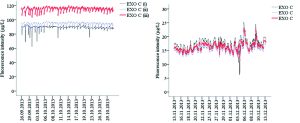On-line monitoring of organic matter concentrations and character in drinking water treatment systems using fluorescence spectroscopy
There is a need for a rapid and robust method of organic matter (OM) monitoring during drinking water treatment. Although it has been shown that fluorescence spectroscopy has the potential for on-line application in drinking water treatment plants, there has been no in situ OM fluorescence monitoring study conducted during drinking water treatment. Three currently available fluorescence probes were chosen for the on-line study of terrestrially-delivered unprocessed (Peak C) and microbially-delivered (Peak T) OM. Probes were installed at two drinking water treatment plants (WTPs) measuring raw water and treated water fluorescence over one month. Probe and sampling point specific temperature correction and inner filter effect correction factors were applied to all fluorescence data. The Peak C fluorescence intensity had a significant correlation with dissolved organic carbon (DOC) concentration (Rs = 0.85–0.93) and it was therefore concluded that it could be used to monitor DOC concentrations in raw and treated water. Peak C and Peak T fluorescence signal changes corresponded to water quality fluctuations and operational conditions enabling OM to be characterised. It was demonstrated that fluorescence probes can be used for monitoring OM concentrations and character in situ and in real-time.
Reference: Shutova, Y., Baker, A., Bridgeman, J., Henderson, R.K., (2016). On-line monitoring of organic matter concentrations and character in drinking water treatment systems using fluorescence spectroscopy, Environmental Science: Water Research & Technology. doi: 10.1039/C6EW00048G




